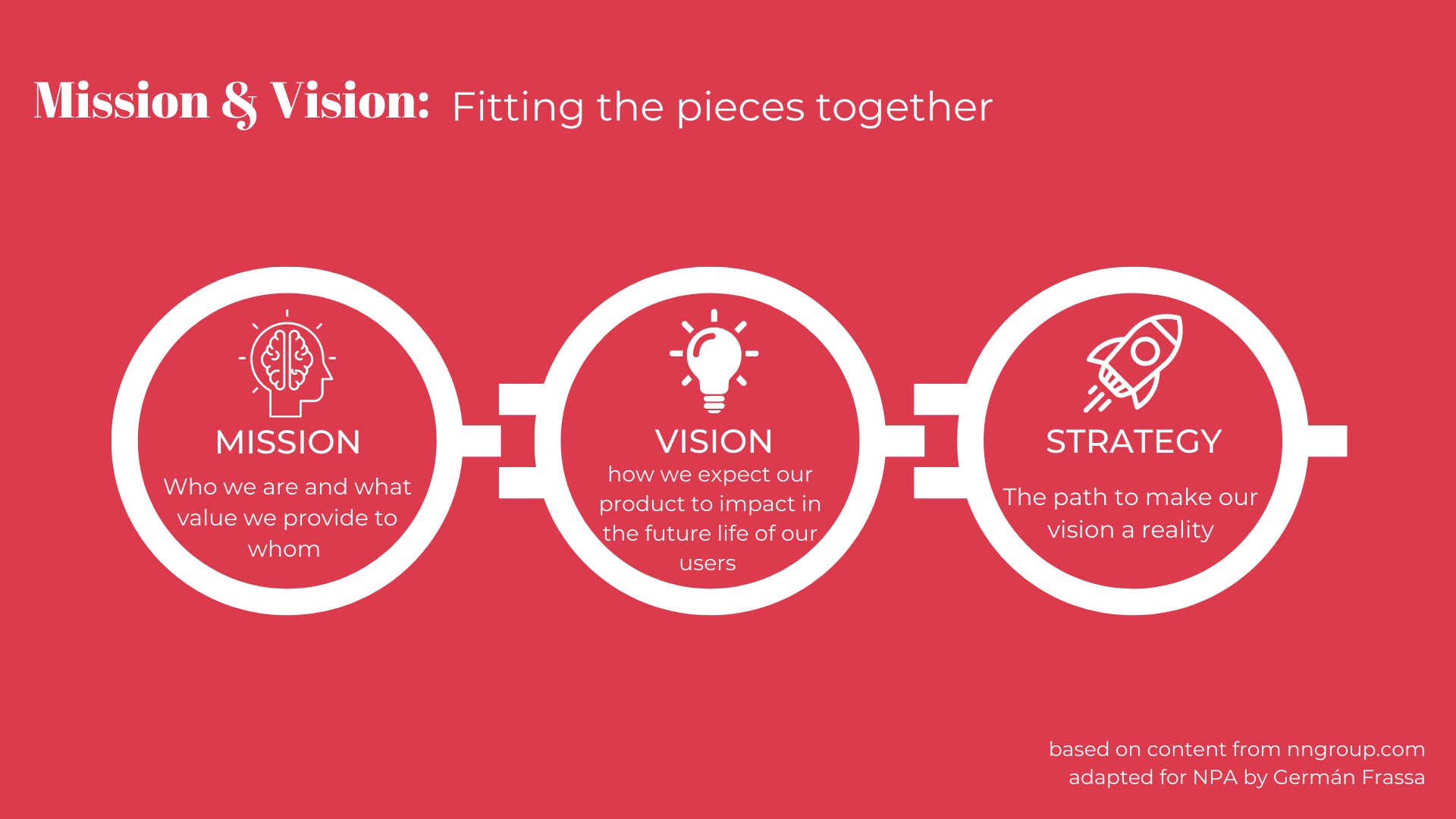Defining your product mission and vision
A guide to defining the mission and vision for product in the newsroom
Presented by Germán Frassa
INTRODUCTION
To make a product without a mission statement or a product vision is like starting a journey without purpose or destination. Without these it is much harder, if not impossible, to set a product strategy or build a lasting value proposition for your audience.
A mission statement is a declaration of your organization’s purpose or reason to exist. From Google's "organize the world's information" to The New York Times' "seek the truth and help people understand the world," mission statements are the first step in the product journey. By being ambitious, but at the same time defining a clear perimeter of operation for the whole organization, they set companies on a path to empower their teams and provide a key ingredient to product strategy: focus.
While writing a mission statement might seem simple, it is easy to fall into many traps: crafting a mission that is actually a slogan, not making the benefit for the user clear, or merely copying the mission of other companies in the same sector.
It can be easy to confuse a mission statement and product vision, but there is a significant difference between these concepts. If a mission is the declared purpose of the organization's journey, a product vision states how the organization imagines the destination.
A product vision describes how an organization believes current social, cultural, and technological trends will shape its product in the future and, in particular, how this product is going to impact the life of users — for the better. Depending on the context, “future” could mean a couple of years, maybe five years, or even a whole decade.
A good product vision is a tool to inspire and align teams and to recruit and retain talent. Product vision is what enabled Netflix, then just a snail mail alternative to DVD rentals, to envision the rise of video streaming. Likewise, a journalistic organization could be currently producing written news in English, but declare that its future is all about producing podcast content in many languages.
Based on content by NNGroup: NNGroup.com
IN PRACTICE
Use the tips and concepts in this section to cultivate a product culture in your newsroom
Start your product journey here
Some news organizations tend to take mission and vision for granted. Many newsrooms jump straight into implementing product teams, workflows or techniques, but find themselves astray without a “North Star” for guidance when things get muddy. OKRs, design sprints, and A/B testing are great techniques to move the project forward, but mission and vision are critical to remind ourselves what the project is about and where it is supposed to be heading.
One mission, one vision
The main purpose of a mission and a product vision is to align everyone within the organization. Therefore, it is crucial to make sure that there is a single version of each for the whole company. It is tempting to take a decentralized approach to popularize these concepts within your company, but getting every team to declare its own mission/vision pair can become a self-defeating proposition.
Onboard your stakeholders early to make sure that your mission and vision really reflect how your organization sees itself and its role in society. Once this is done, spread the word across your teams. These statements are not meant to be buried in a desk drawer, but to be known — and applied — by everyone inside the company.
It’s all about the user
Creating a mission statement and a product vision is the first of many moments in the product journey where we are required to stop thinking about ourselves and focus on the user. This is not the time to aspire to be a market leader, crush your competitors, or find a way to make your business sustainable. It’s better to to think of unique, ambitious ways to have a positive impact on your audience — from their point of view.
Be inspired, not maddened, by tech
Remember all those news outlets in the 2000s that opened offices in Second Life? In the digital era, every media organization is a de facto tech company. But in a world where tech trends are constantly emerging and fading, there is a thin line between being inspired by technology and chasing every tech fad.
When drafting your mission and vision statements, consider long-term technology trends that could change the landscape and open opportunities for your organization, but avoid running after or getting boxed in by the idea of innovation. Some of the most impactful recent developments in the news sector are based on relatively primitive technologies, like email newsletters or podcasts. Focus on value, not fireworks.
TERMS
Definitions for product terms referenced in this guide are sourced from NPA’s crowd-sourced product glossary
OKRs (Objectives and Key Results)
A goal-setting framework that describes what you want to achieve and how to do so. These can also be used to create linked goals, i.e. Objective: Increase newsletter engagement → Key result: Increase click-through rate from 3% to 6% by 1-year mark.
Sprint
A defined period of time when a team works to complete a set amount of work; common in agile development styles.
Stakeholder
The people with interest in or who may be affected by a product’s outcome. Stakeholders may be internal and cross-departmental (e.g. editorial, marketing, development, etc.), and external (e.g. product audience/user base).
Value Proposition
A description of what benefit the user will get from your product. This is crucial to understand and define before product development begins.
RELATED READINGS / RESOURCES
Product Vision vs. Mission- svpg.com
Product Vision FAQ- svpg.com
Mission vs. vision statements: definitions & examples - atlassian.com
What is good product strategy? - Melissaperri.com
ABOUT THE AUTHOR
Germán Frassa
Germán Frassa is a journalist and product leader with a long experience in the implementation of product and audience development teams in newsrooms. Between 2010 and 2021, Germán was Product Director of the Spanish newspapers El Mundo, Marca and Expansión. He is currently the Director of Product Strategy at sports website Relevo, and also trains and mentors media organizations across Latin America. He is the author of "Productos Digitales: el proceso de creación" (TVDBS, 2017), one of the first books in Spanish about digital product management.
Puoi leggere questa guida tradotta e adattata in italiano dalla nostra associata Clara Attene: Definire la mission e la visione del prodotto
Puedes leer la guía traducida y adaptada al español aquí: Definiendo la misión y la visión de su producto
Você pode ler o guia traduzido e adaptado para português aqui: Definindo a missão e a visão do seu produto



